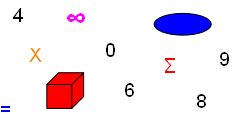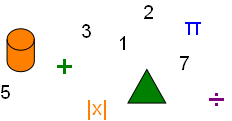



Factoring Quadratic Equations


Factoring Quadratic Equations is by mathematical change of form to terms of an equation. By simplifying the form what remains is single degree factors that when multiplied together equate to its quadratic polynomial form.
To factor the standard form Quadratic Equation, x2 + 2x − 8 = 0:
Identify the elements of the standard form ax2 + bx + c = 0
ax2 = x2, second degree term having a coefficient of 1 (a = 1)
bx = 2x, first degree term having a coefficient of 2 (b = 2)
c = −8, a constant
Setup the factors as: (x ) (x ) = 0
Find combinations of two numbers that when multiplied equal the constant (−8).
[ −2, 4 ], [ 2, −4 ], [ 1, −8 ] or [ −1, 8 ]
Choose a number combination that when added equal the coefficient of the first-degree term 2x (coefficient is 2).
[ −2, 4 ]
Complete factors by plugging the number combination into setup.
(x − 2) (x + 4) = 0
x2 + 2x − 8 = (x − 2) (x + 4) = 0
(x − 2) and (x + 4) are multiplied. The quadratic equation equals zero when either factor equals zero. Set each factor equal to zero and solve for x.
(x − 2) = 0 when x = 2
(x + 4) = 0 when x = −4
Values of x that solve the equation are 2 and −4.
Factoring and solving a quadratic equation when the second degree term coefficient is greater than one is more challenging. It requires number combinations that multiplied satisfy the second term coefficient (middle term), third term constant, and the first term of second degree.
6x2 + 3x = 4x + 2
Rewrite the equation so that one side is zero.
6x2 − x − 2 = 0
Create setup of (x ) (x ).
Coefficient of second-degree term is 6. Factors of 6 are:
[ 3, 2 ], [ 1, 6 ]
Constant is −2. Factors of −2 are [ 1, −2 ], [ −1, 2 ]
Complete the factors.
(3x − 2) (2x + 1)
6x2 − x − 2 = (3x − 2) (2x + 1) = 0
It is sometimes by trial and error to determine the correct number combination.
(3x − 2) = 0 when x = 2/3
(2x + 1) = 0 when x = −1/2
Values of x that solve the equation are 2/3 and −1/2.
Copyright © DigitMath.com
All Rights Reserved.